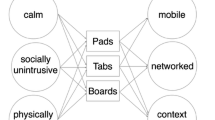Abstract
Infrastructures (persistent socio-technical systems over which services are delivered) are normally taken for granted by their users, but are powerful forces of constraint and enablement with implications for the design, use, and adoption of ubiquitous computing. To approach the study of infrastructure from an ethnographic perspective, we conducted an exploratory field study of people for whom infrastructure had become visible due to some form of active engagement (rejecting, augmenting, or caretaking). From considering together individuals as disparate as homeschoolers, gated community dwellers, and voluntary simplicity advocates, a number of challenges and opportunities for ubicomp emerged in terms of appropriation, empowerment, and reflection.
Access this chapter
Tax calculation will be finalised at checkout
Purchases are for personal use only
Preview
Unable to display preview. Download preview PDF.
Similar content being viewed by others
References
Weiser, M.: The computer for the 21st century. Scientific American 265(3), 66–75 (1991)
Davies, N., Gellersen, H.-W.: Beyond prototypes: Challenges in deploying ubiquitous systems. IEEE Pervasive Computing 1(1), 26–35 (2002)
Satyanarayanan, M.: Pervasive computing: Vision and challenges. IEEE Personal Communications 8(4), 10–17 (2001)
Tolmie, P., Pycock, J., Diggins, T., MacLean, A., Karsenty, A.: Ubiquity: Unremarkable computing. In: Proceedings of the CHI (2002)
Brun-Cottan, F., Wall, P.: Using video to re-present the user. Communications of the ACM 38(5), 61–71 (1995)
Crabtree, A., Rodden, T., Hemmings, T., Benford, S.: Finding a place for UbiComp in the home. In: Dey, A.K., Schmidt, A., McCarthy, J.F. (eds.) UbiComp 2003. LNCS, vol. 2864, pp. 208–226. Springer, Heidelberg (2003)
Flanagan, J.C.: The critical incident technique. Psychological Bulletin 51, 327–358 (1954)
Star, S.L.: The ethnography of infrastructure. American Behavioral Scientist 43(3), 377–391 (1999)
Palen, L., Salzman, M., Youngs, E.: Discovery and integration of mobile communications in everyday life. Personal and Ubiquitous Computing 5(2), 109–122 (2001)
Lally, E.: At home with computers. Berg (2002)
Bielick, S., Chandler, K., Broughman, S.: Homeschooling in the United States: 1999. National Center for Education Statistics (2001)
Stevens, M.: Kingdom of children: Culture and controversy in the homeschooling movement. Princeton University Press, Princeton (2001)
Low, S.M.: Behind the gates: Life, security and the pursuit of happiness in fortress America. Routledge, New York (2003)
Blakely, E.J., Snyder, M.G.: Fortress America: Gated communities in the United States. The Brookings Institution (1997)
McKenzie, E.P.: Homeowner associations and the rise of residential private government. Yale University Press, New Haven (1996)
Elgin, D.: Voluntary simplicity: Toward a way of life that is outwardly simple, inwardly rich. Quill (1998)
Giddens, A.: The consequences of modernity. Polity Press/Stanford University Press (1990)
Bowker, G.C., Star, S.L.: Sorting things out: Classification and its consequences. MIT Press, Cambridge (1999)
Star, S.L., Ruhleder, K.: Steps toward an ecology of infrastructure: Design and access for large information spaces. Information Systems Research 7(1), 111–134 (1996)
Giddens, A.: Modernity and self-identity: Self and society in the late modern age, p. 125. Stanford University Press, Stanford (1991)
Edwards, W.K., Grinter, R.E.: At home with ubiquitous computing: Seven challenges. In: Abowd, G.D., Brumitt, B., Shafer, S. (eds.) UbiComp 2001. LNCS, vol. 2201, pp. 256–272. Springer, Heidelberg (2001)
Rodden, T., Benford, S.: Domesticated design: The evolution of buildings and implications for the design of ubiquitous domestic environments. In: Proceedings of CHI 2003 (2003)
Schilit, B., LaMarca, A., Borriello, B., Griswold, W., McDonald, D., Lazowska, E., Bala-chandran, A., Hong, J., Iverson, V.: Challenge: Ubiquitous location-aware computing and the Place Lab initiative. In: Proceedings of The First ACM International Workshop on Wireless Mobile Applications and Services on WLAN, WMASH 2003 (2003)
Schmidt, T., Townsend, A.: Why Wi-Fi wants to be free. CACM 46(5), 47–52 (2003)
Morris, M., Lundell, J., Dishman, E., Needham, B.: New perspectives on ubiquitous computing from ethnographic study of elders with cognitive decline. In: Dey, A.K., Schmidt, A., McCarthy, J.F. (eds.) UbiComp 2003. LNCS, vol. 2864, pp. 227–242. Springer, Heidelberg (2003)
Hirsch, T., Csikszentmihályi, C.: Sensible Cities Project, http://www.media.mit.edu/research/ResearchPubWeb.pl?ID=55
Palen, L., Dourish, P.: Unpacking “privacy” for a networked world. In: Proceedings of CHI 2003 (2003)
Bellotti, V., Back, M., Edwards, W.K., Grinter, R.E., Henderson, A., Lopes, C.: Making sense of sensing systems: Five questions for designers and researchers. In: Proceedings of the CHI 2002 (2002)
Weiser, M., Brown, J.S.: The coming age of calm technology. In: Beyond calculation: The next fixty years (1997)
Garfinkle, H.: The conception of, and experiments with, “trust” as a condition of stable and concerted actions. In: Harvey, O.J. (ed.) Motivation and social interaction, Ronald Press (1963)
Author information
Authors and Affiliations
Editor information
Editors and Affiliations
Rights and permissions
Copyright information
© 2004 Springer-Verlag Berlin Heidelberg
About this paper
Cite this paper
Mainwaring, S.D., Chang, M.F., Anderson, K. (2004). Infrastructures and Their Discontents: Implications for Ubicomp. In: Davies, N., Mynatt, E.D., Siio, I. (eds) UbiComp 2004: Ubiquitous Computing. UbiComp 2004. Lecture Notes in Computer Science, vol 3205. Springer, Berlin, Heidelberg. https://doi.org/10.1007/978-3-540-30119-6_25
Download citation
DOI: https://doi.org/10.1007/978-3-540-30119-6_25
Publisher Name: Springer, Berlin, Heidelberg
Print ISBN: 978-3-540-22955-1
Online ISBN: 978-3-540-30119-6
eBook Packages: Springer Book Archive



